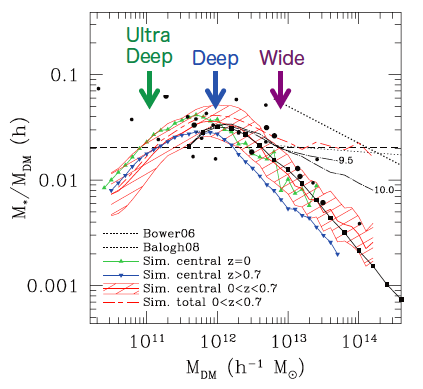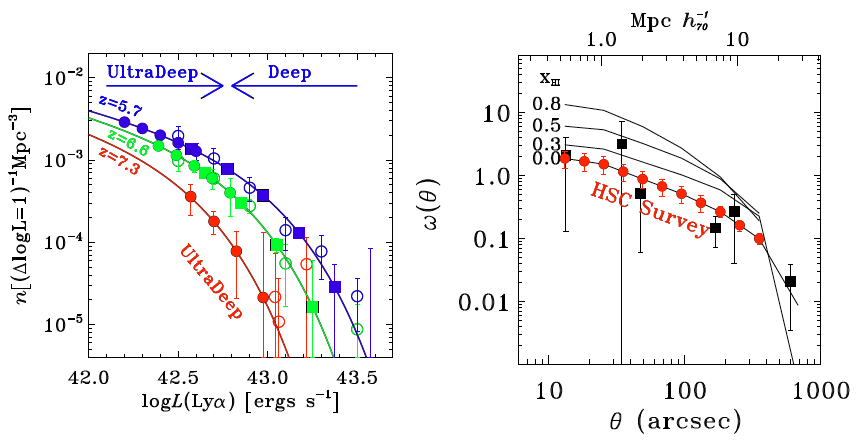High Redshift Galaxies
We are interested in learning more about how stars form in galaxies. What kinds of environments are best suited to star formation? At what point in the expansion of the universe are most stars formed?
Hydrogen is the most ubiquitous element in the Universe and it should come as no surprise that much of the astronomical signal that we measure is connected with this element. When a proton captures an electron, it forms a neutral hydrogen atom. When neutral hydrogen in its ground state absorbs radiation, this is known as Lyman-alpha absorption, and when neutral hydrogen in an excited energy state emits a photon to return to its ground state, this is known as Lyman-alpha emissions. A cloud of neutral hydrogen will absorb all radiation higher than 912 Angstroms, and this generates an observable feature known as the Lyman break. The mechanism of Lyman-alpha absorption and emission provides astronomers with a valuable tool to study the high redshift universe. Various star-forming astronomical bodies produce distinctive observational signatures via the Lyman-alpha line and are named accordingly, such as, Lyman-break galaxies, Lyman- alpha emitters, and Lyman-alpha blobs. HSC’s precursor, Suprime-Cam, helped to unveil the physical properties of these objects, their environments and how these objects evolved and clustered from z = 2 to z=7. Compared to Suprime-Cam, HSC will be able to map much larger areas of the sky, it will be able to measure light from more distant galaxies, and with its narrow-band (NB) lters (unique to HSC-alone!) it will be able to speci cally target the measurement of Lyman-alpha emission itself.
The major goals of our HSC high-redshift galaxy studies are as follows:
- To characterize star formation and stellar populations at z = 2-7 (and z = 7-9), based on precision measurements of how much light is produced by galaxies of various luminosities (i.e., the luminosity function, LF), and how galaxies are clustered (i.e., the angular correlation function, ACF), and, as demonstrated in Figure 1, through comparison with numerical simulations and predictions of how galaxies trace their dark matter halos (e.g. halo occupation distribution (HOD) models). To paint as complete a picture as possible, we also plan to incorporate deep near-infrared images of UKIDSS and VISTA, in our studies using HSC data.
- To study the gas extent and motions of galaxies with spatially extended Lyman alpha emission, often referred to as Lyman alpha blobs (LABs).
- To derive the neutral fraction of hydrogen in the universe at z = 7, before it is ionized by the energy released during star formation, using the evolution of LF and ACF of LAEs (see Figure 2). Speci cally, we will constrain the LF of star-forming galaxies at z = 7, and measure the escape fraction of ionizing photons of star-forming galaxies at z = 3-5, to answer the question of whether galaxies alone can ionize the universe at z < 7 or we need additional ionizing sources such as AGNs.
- To identify hundreds of proto-cluster candidates, in order to constrain structure formation of the Universe.
To achieve these goals, we will primarily use the data from Deep and Ultradeep (UD) layers, supplemented by the Wide data for very luminous objects. The broad-band depths of each layer are designed to select LBGs over the full redshift range 2 < z < 7, as well as to detect the continuum in LAEs, at all redshifts probed by the NB data. The depths and area will allow us to accurately measure the clustering and luminosity functions of these populations. In the Ultradeep layer, the z- and y-band filters will reach to L* at z = 7, allowing the selection of dropout galaxies. With the NB lters, we will study the evolution of LAEs up to z = 7.3, the nature of LABs, the Lyman continuum escape fraction of galaxies, and the topology of reionization at z = 6-7. Our z = 2.2 LAE/LAB samples provide the best targets for detailed follow-up studies, because only at these redshifts among z > 2, important optical nebular lines up to H alpha are all accessible from the ground. The Lyman- break and narrow-band excess techniques are well established, and we will need spectroscopic confirmation for only a small fraction of our objects (except for the rare objects at z>~7), meaning that follow-up spectroscopy will not be a bottleneck in our study.
Our samples include a large number of very distant galaxies, candidates of primordial galaxies, ionizing sources, proto-clusters, and metal-deficit galaxies. They will be excellent targets of follow-up spectroscopy and multi-wavelength observations by Subaru/PFS, ALMA, ELT, SPICA, and JWST.

Figure 1: Stellar-to-halo mass ratio (SHMR) as a function of halo mass from Figure 6 of Foucaud et al. (2010). The three arrows in the top panel indicate the typical mass scales probed by the three layer data. The combination of the three layer data will cover 1011 – 1013 Msun, bracketing the predicted peak at ~ 1012 Msun.

Figure 2: (Left) Expected measurements of the Lya LFs at z = 5.7 (blue), 6.6 (green), and 7.3 (red) with the Ultradeep and Deep layer data. The existing Suprime-Cam measurements at z = 7.3 go very deep, although over a very small area. The open circles are the current best measurements given by Suprime-Cam observations. The decrease in the LF with increasing redshift is interpreted as due to the onset of reionization. (Right) Expected ACF Omega(theta) of z = 6.6 LAEs from the Deep layer in the case of full ionization, assuming that they are hosted by Mhalo = 3 x 1010 Msun halos (red dots). The solid curves indicate the ACFs of LAEs with Mhalo = 3 x 1010 Msun for xHI = 0, 0.3, 0.5, 0.8 taken from McQuinn et al. (2007) simulations of inhomogeneous reionization. The black squares are the best estimates of the z = 6.6 LAE ACF available to date (Ouchi et al. 2010). Our accurate ACF measurements over a range of a factor of 30 in theta will allow us to detect the difference in the ACF shape between the full and partial ionization cases and to constrain xHI with an uncertainty of ~ 0.2.
